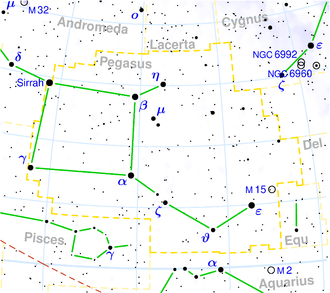NGC 7672
| Galaxie NGC 7672 | |
|---|---|
 | |
| AladinLite | |
| Sternbild | Pegasus |
| Position Äquinoktium: J2000.0, Epoche: J2000.0 | |
| Rektaszension | 23h 27m 31,4s[1] |
| Deklination | +12° 23′ 07″ [1] |
| Erscheinungsbild | |
| Morphologischer Typ | Sb / Sy2 [1][2] |
| Helligkeit (visuell) | 13,9 mag [2] |
| Helligkeit (B-Band) | 14,7 mag [2] |
| Winkelausdehnung | 0,8' × 0,6' [2] |
| Positionswinkel | 36° [2] |
| Flächenhelligkeit | 13,9 mag/arcmin² [2] |
| Physikalische Daten | |
| Rotverschiebung | 0.013376 ± 0.000087 [1] |
| Radialgeschwindigkeit | 4010 ± 26 km/s [1] |
| Hubbledistanz vrad / H0 | (186 ± 13) · 106 Lj (57,1 ± 4,0) Mpc [1] |
| Geschichte | |
| Entdeckung | R. J. Mitchell |
| Entdeckungsdatum | 23. Oktober 1857 |
| Katalogbezeichnungen | |
| NGC 7672 • PGC 71485 • CGCG 431-070 • MCG +02-59-045 • IRAS 23249+1206 • 2MASX J23273143+1223065 • GALEXASC J232731.43+122307.0 • LDCE 1576 NED004 • NVSS J232731+122307 | |
NGC 7672 ist eine Spiralgalaxie mit aktivem Galaxienkern vom Hubble-Typ Sb im Sternbild Pegasus am Nordsternhimmel. Sie ist schätzungsweise 186 Millionen Lichtjahre von der Milchstraße entfernt und hat einen Durchmesser von etwa 45.000 Lichtjahren. Möglicherweise bildet er mit NGC 7671 ein gravitativ gebundenes Galaxienpaar.
Das Objekt wurde am 23. Oktober 1857 vom irischen Astronomen R. J. Mitchell, einem Assistenten von William Parsons, entdeckt.[3]
Weblinks
Einzelnachweise
Auf dieser Seite verwendete Medien
Autor/Urheber: Sloan Digital Sky Survey, Lizenz: CC BY 4.0
The sky image is obtained by Sloan Digital Sky Survey, DR14 with SciServer.
Angle of view: 4' × 4' (0.3" per pixel), north is up.
Details on the image processing pipeline: https://www.sdss.org/dr14/imaging/jpg-images-on-skyserver/



